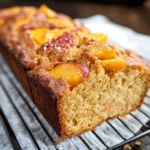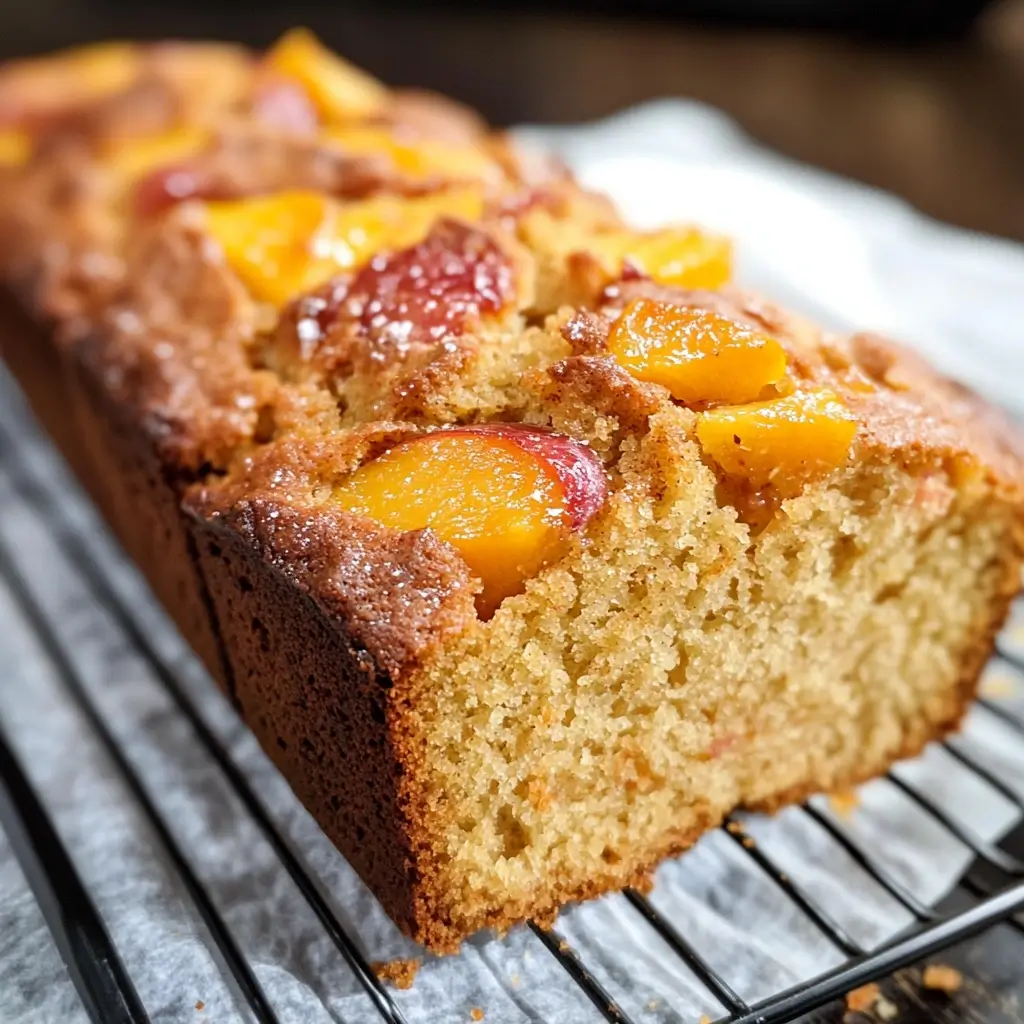There are certain aromas that instantly transport you back to a feeling of comfort, warmth, and pure, simple joy. For me, the scent of this Easy Spiced Peach Bread baking in the oven is definitely one of them. The first time I made this recipe, it was a slightly gloomy late summer afternoon. The air had a hint of the coming autumn chill, and I had a bowl full of perfectly ripe peaches sitting on the counter, practically begging to be used. I wanted something easy, something comforting, something that would fill the house with a welcoming fragrance. This recipe delivered on all fronts, and then some. As the bread baked, the sweet perfume of peaches mingled with the cozy warmth of cinnamon, nutmeg, and a hint of ginger, creating an olfactory hug that enveloped the entire kitchen. When it finally emerged from the oven, golden brown and promising moist deliciousness, my family gathered around, drawn by the irresistible smell. The first slice, slightly warm, was pure bliss – tender, packed with juicy peach pieces, and perfectly balanced with the gentle spice blend. My kids, usually picky eaters when it comes to anything with fruit chunks, devoured their slices and even asked for seconds for their lunchboxes the next day. My partner declared it the “best quick bread ever,” enjoying it with a simple cup of coffee. Since that first bake, this Easy Spiced Peach Bread has become a staple in our home, especially during that lovely transition from late summer into fall. It’s incredibly straightforward to whip up, making it perfect for beginner bakers or busy afternoons, yet the results taste like something truly special. It’s the kind of recipe that creates happy memories, fills your home with warmth, and leaves everyone feeling satisfied and content. It’s more than just a bread; it’s a slice of comfort.
Easy Spiced Peach Bread: Ingredients
To embark on this delightful baking journey, you’ll need a handful of common pantry staples along with those luscious peaches. Precision in measurement is key in baking, ensuring the perfect texture and balance of flavors. Here’s what you’ll need to gather:
- All-Purpose Flour: 2 cups (approximately 250g). Make sure to spoon the flour into your measuring cup and level it off with a straight edge, rather than scooping directly from the bag, to avoid packing it too tightly. This is the structural backbone of our bread.
- Granulated Sugar: 1 cup (approximately 200g). Provides sweetness and contributes to the tender crumb and golden crust.
- Light Brown Sugar: ½ cup, packed (approximately 110g). Adds a deeper, molasses-like flavor and extra moisture compared to using only granulated sugar. Packing it ensures you get the right amount.
- Baking Soda: 1 teaspoon. Our primary chemical leavening agent, reacting with acidic components (like potentially brown sugar or buttermilk, if used) to create lift.
- Baking Powder: ½ teaspoon. Provides additional leavening power, ensuring a good rise, especially reacting when heated. Using both soda and powder gives a reliable and well-textured result.
- Salt: ½ teaspoon. Crucial for balancing the sweetness and enhancing all the other flavors, including the spices and peaches. Don’t skip it!
- Ground Cinnamon: 1 ½ teaspoons. The star spice, providing that classic warm, comforting flavor that pairs beautifully with peaches.
- Ground Nutmeg: ½ teaspoon. Adds a warm, slightly sweet, and nutty note. Freshly grated nutmeg offers superior flavor if you have it.
- Ground Ginger: ¼ teaspoon. Brings a subtle warmth and zing that complements the cinnamon and nutmeg.
- Ground Cloves or Allspice: ¼ teaspoon (Optional, but recommended). Adds depth and complexity to the spice profile. Use cloves for a stronger, pungent warmth or allspice for a blend reminiscent of cinnamon, nutmeg, and cloves.
- Large Eggs: 2. Should be at room temperature for better incorporation into the batter. Eggs act as binders, add richness, moisture, and help with leavening.
- Vegetable Oil (or Melted Butter): ½ cup (120ml). Provides moisture and tenderness. Vegetable oil generally results in a slightly moister bread that stays soft longer, while melted butter contributes a richer flavor. Ensure butter is cooled slightly after melting.
- Milk or Buttermilk: ¼ cup (60ml). Adds necessary liquid and moisture. Buttermilk can add a slight tang and contribute to a more tender crumb due to its acidity reacting with the baking soda. Room temperature is preferred.
- Vanilla Extract: 1 teaspoon. Enhances the overall sweetness and rounds out the flavors. Pure vanilla extract is recommended for the best taste.
- Diced Peaches: 1 ½ cups, fresh, canned, or frozen.
- Fresh Peaches: Use ripe but firm peaches. You’ll need about 2-3 medium peaches. Peel, pit, and dice them into roughly ½-inch pieces.
- Canned Peaches: Drain them very thoroughly. Pat them dry with paper towels to remove excess moisture, which can make the bread soggy. Dice into ½-inch pieces. Use peaches packed in juice or light syrup, not heavy syrup if possible.
- Frozen Peaches: Thaw completely and drain off all excess liquid. Pat them thoroughly dry with paper towels before dicing. Excess water is the enemy here.
Instructions: Baking Your Spiced Peach Bread
Follow these steps carefully for a perfectly baked loaf. Baking is a science, and the order and technique matter!
- Preheat and Prepare: Preheat your oven to 350°F (175°C). Generously grease and flour a standard 9×5 inch loaf pan. Alternatively, line the pan with parchment paper, leaving an overhang on the two longer sides for easy removal of the bread after baking. This parchment paper sling method is highly recommended.
- Combine Dry Ingredients: In a large mixing bowl, whisk together the all-purpose flour, granulated sugar, packed light brown sugar, baking soda, baking powder, salt, ground cinnamon, ground nutmeg, ground ginger, and optional ground cloves/allspice. Whisking well ensures the leavening agents and spices are evenly distributed, which is crucial for a consistent texture and flavor throughout the loaf. Break up any clumps of brown sugar.
- Combine Wet Ingredients: In a separate medium-sized bowl, whisk together the room temperature large eggs until lightly beaten. Then, whisk in the vegetable oil (or cooled melted butter), milk (or buttermilk), and vanilla extract until well combined and smooth.
- Combine Wet and Dry: Pour the wet ingredients into the bowl containing the dry ingredients. Using a rubber spatula or wooden spoon, mix just until combined. Be very careful not to overmix at this stage. Some streaks of flour remaining are perfectly fine. Overmixing develops the gluten in the flour, which will result in a tough, dense bread instead of a tender, moist one.
- Fold in Peaches: Gently fold the prepared (diced and patted dry, if necessary) 1 ½ cups of peaches into the batter using your spatula. Distribute them evenly throughout the batter without vigorously stirring. Again, minimal mixing is key.
- Transfer to Pan: Pour the thick batter into the prepared loaf pan, spreading it evenly with the spatula. If the batter seems very thick, this is normal for this type of quick bread.
- Bake: Place the loaf pan in the center rack of the preheated oven. Bake for 55 to 70 minutes. Baking times can vary depending on your oven and the moisture content of your peaches.
- Check for Doneness: Start checking for doneness around the 55-minute mark. The bread should be beautifully golden brown on top and feel set. Insert a long wooden skewer or toothpick into the absolute center of the loaf. If it comes out clean (with no wet batter clinging to it, though a few moist crumbs are okay), the bread is done. If there’s wet batter, continue baking in 5-minute increments, checking each time. Another way to check is with an instant-read thermometer; the internal temperature should register around 200-205°F (93-96°C).
- Cooling (Crucial Step!): Once baked, remove the loaf pan from the oven and place it on a wire cooling rack. Let the bread cool in the pan for at least 15-20 minutes. This allows the structure to set, preventing it from collapsing or breaking when you remove it.
- Complete Cooling: After the initial cooling period in the pan, carefully run a thin knife or offset spatula around the edges if you didn’t use parchment paper. If you used a parchment sling, simply lift the bread out using the overhangs. Place the loaf directly onto the wire rack to cool completely before slicing and serving. Cooling completely might take 1-2 hours, but patience is rewarded with bread that slices cleanly and has the best texture. Slicing while too warm can lead to a gummy texture.
Nutrition Facts
- Servings: This recipe typically yields 10-12 slices, depending on how thickly you slice the loaf.
- Calories per Serving (Estimated): Approximately 280-350 calories per slice.
Disclaimer: Nutritional information is an estimate only, calculated using standard ingredient databases. Actual values may vary based on specific ingredients used (e.g., type of oil, sugar content of canned peaches, size of eggs), portion size, and any modifications made to the recipe.
Preparation Time
Understanding the time commitment helps plan your baking session:
- Prep Time: 15-20 minutes. This includes gathering and measuring ingredients, preparing the peaches (peeling, dicing, drying if needed), mixing the batter, and preparing the loaf pan.
- Cook Time: 55-70 minutes. Oven time can vary, so rely on doneness tests.
- Cooling Time: Approximately 1.5 – 2.5 hours (15-20 minutes in the pan + 1-2 hours completely on the rack). This is essential time and should not be rushed.
- Total Time (excluding full cooling): Approximately 1 hour 10 minutes to 1 hour 30 minutes from starting prep to removing from the oven.
How to Serve Your Spiced Peach Bread
This Easy Spiced Peach Bread is wonderfully versatile and delicious in many ways. Here are some serving suggestions to elevate your experience:
- Simply As Is: Enjoy a slice completely unadorned, either slightly warm or at room temperature. This allows the pure flavors of the spiced peach bread to shine through. Perfect with your morning coffee or afternoon tea.
- With a Smear of Butter: A classic choice. Spread a thin layer of salted or unsalted butter on a slice. If the bread is warm, the butter will melt slightly, creating an irresistible treat.
- Topped with Cream Cheese: The slight tang of plain cream cheese provides a beautiful contrast to the sweetness of the bread. For an extra touch, try whipped cream cheese or a honey-nut flavored variety.
- Drizzled with a Simple Glaze: Whisk together about ½ cup of powdered sugar with 1-2 tablespoons of milk or lemon juice until smooth. Drizzle this simple glaze over the cooled loaf for an extra touch of sweetness and visual appeal. A maple glaze (using maple syrup instead of milk) would also be delicious.
- Alongside Whipped Cream: Serve a warm slice as a dessert topped with a dollop of freshly whipped cream (sweetened or unsweetened) and perhaps an extra sprinkle of cinnamon.
- With a Scoop of Ice Cream: For an indulgent dessert, pair a warm slice of spiced peach bread with a scoop of high-quality vanilla bean or butter pecan ice cream. The contrast between the warm, spiced bread and the cold, creamy ice cream is heavenly.
- Served with Yogurt: For a healthier breakfast or snack option, serve a slice alongside a bowl of plain Greek yogurt. Add a sprinkle of granola or extra chopped nuts for texture.
- Toasted: Day-old slices can be lightly toasted in a toaster oven or under a broiler until slightly crisp and warmed through. This revives the texture and enhances the aromas. Serve toasted slices with butter or jam.
- As French Toast: For a truly decadent breakfast or brunch, use thicker slices of day-old peach bread to make French toast! Dip in an egg-milk-cinnamon mixture and pan-fry until golden brown. Serve with maple syrup and perhaps some fresh peach slices.
Additional Tips for Perfect Spiced Peach Bread
Want to ensure your bread turns out fantastic every single time? Here are five extra tips:
- Master Your Peach Prep: The state of your peaches significantly impacts the final bread. If using fresh, choose ripe but firm ones to hold their shape. For canned or frozen, thorough draining and patting dry cannot be overstressed. Excess liquid will make your batter too wet, potentially leading to a soggy bottom or center and increasing bake time. Tossing the diced peaches lightly in a tablespoon of the measured flour before adding them to the batter can also help prevent them from sinking to the bottom of the loaf.
- Embrace the “Do Not Overmix” Rule: This is the golden rule of quick breads (like muffins and loaves that use chemical leaveners instead of yeast). Mixing activates gluten development in the flour. A little gluten is needed for structure, but too much makes the bread tough, chewy, and dense instead of tender and crumbly. Mix the wet and dry ingredients only until they are just combined – stop as soon as you don’t see large pockets of dry flour. Lumps are okay! Gently fold in the peaches.
- Know Your Oven & Test Doneness Reliably: Ovens can vary significantly in temperature accuracy. An inexpensive oven thermometer can tell you if your oven runs hot or cold, allowing you to adjust accordingly. When testing for doneness, always insert the toothpick or skewer into the thickest part of the center of the loaf, as this is the last part to cook through. Relying solely on color can be deceiving. The internal temperature check (200-205°F / 93-96°C) is the most foolproof method if you have an instant-read thermometer.
- Experiment with Add-Ins and Toppings: Feel free to customize! Consider adding ½ cup of chopped walnuts or pecans to the batter along with the peaches for a delightful crunch. A sprinkle of coarse sugar (like turbinado) over the top before baking adds a lovely sparkle and slight crunch. You could also create a simple crumble topping (mix equal parts flour, brown sugar, and cold cubed butter with a pinch of cinnamon until crumbly) and sprinkle it over the batter before baking for a coffee-cake style bread.
- Proper Storage for Lasting Freshness: Allow the bread to cool completely before storing. Store it in an airtight container or wrap it tightly in plastic wrap or aluminum foil at room temperature for up to 3 days. While you can store it in the refrigerator to extend its life slightly (up to a week), be aware that refrigeration can actually dry out quick breads faster. For longer storage, freeze the bread. You can freeze the whole loaf or individual slices. Wrap tightly in plastic wrap, then again in aluminum foil or place in a freezer-safe bag. It will keep well in the freezer for 2-3 months. Thaw at room temperature or gently reheat slices in a toaster oven or microwave.
Frequently Asked Questions (FAQ)
Here are answers to some common questions about making this Easy Spiced Peach Bread:
- Q: Can I use peaches packed in heavy syrup?
- A: Yes, you can, but it’s less ideal than peaches packed in juice or light syrup. If using peaches in heavy syrup, you must drain them extremely well and rinse them gently under cold water to remove excess syrup. Pat them very dry with paper towels. Be aware that they might make the final bread slightly sweeter, so you could consider reducing the granulated sugar by a tablespoon or two if you prefer. Thorough draining and drying is the most critical step.
- Q: My bread came out dense and heavy. What went wrong?
- A: Several factors could cause a dense quick bread. The most common culprit is overmixing the batter after combining the wet and dry ingredients. Remember to mix just until combined. Other possibilities include: using expired baking soda or baking powder (check the dates – they lose potency over time), inaccurate measurement of flour (scooping directly from the bag packs too much flour), or your oven temperature being too low, preventing a proper rise before the structure set.
- Q: Can I substitute whole wheat flour to make it healthier?
- A: You can experiment with substituting some of the all-purpose flour with whole wheat flour, but it will change the texture and flavor. Start by replacing only 25-50% (½ cup to 1 cup) of the all-purpose flour with whole wheat flour. Whole wheat flour absorbs more liquid, so you might need to add an extra tablespoon or two of milk if the batter seems excessively thick. The resulting bread will be denser and have a nuttier, earthier flavor. Using 100% whole wheat flour is not recommended for this recipe without significant adjustments, as it could become very heavy. Using white whole wheat flour is a good intermediate option.
- Q: Could I bake this recipe as muffins instead of a loaf?
- A: Absolutely! This recipe adapts well to muffins. Grease and flour a standard 12-cup muffin tin or line it with paper liners. Fill each cup about two-thirds full with batter. The baking time will be significantly shorter than for a loaf. Start checking for doneness around 18-20 minutes. They are done when a toothpick inserted into the center of a muffin comes out clean. You should get approximately 12-14 standard-sized muffins.
- Q: How do I know if my peaches are ripe enough but not too mushy?
- A: For fresh peaches, look for vibrant color (depending on the variety, a yellow background with red blush) and a slight give when gently pressed near the stem. Avoid peaches that are rock hard or overly soft and bruised. They should have a sweet, fragrant aroma. Ripe but firm peaches are ideal because they will soften during baking but still hold their shape reasonably well, providing distinct fruity pieces in the bread rather than dissolving completely into mush. If your peaches are slightly underripe, the flavor might be less intense; if they are very soft, be extra gentle when folding them in, and they might break down more during baking.

Easy Spiced Peach Bread Recipe
Ingredients
- All-Purpose Flour: 2 cups (approximately 250g). Make sure to spoon the flour into your measuring cup and level it off with a straight edge, rather than scooping directly from the bag, to avoid packing it too tightly. This is the structural backbone of our bread.
- Granulated Sugar: 1 cup (approximately 200g). Provides sweetness and contributes to the tender crumb and golden crust.
- Light Brown Sugar: ½ cup, packed (approximately 110g). Adds a deeper, molasses-like flavor and extra moisture compared to using only granulated sugar. Packing it ensures you get the right amount.
- Baking Soda: 1 teaspoon. Our primary chemical leavening agent, reacting with acidic components (like potentially brown sugar or buttermilk, if used) to create lift.
- Baking Powder: ½ teaspoon. Provides additional leavening power, ensuring a good rise, especially reacting when heated. Using both soda and powder gives a reliable and well-textured result.
- Salt: ½ teaspoon. Crucial for balancing the sweetness and enhancing all the other flavors, including the spices and peaches. Don’t skip it!
- Ground Cinnamon: 1 ½ teaspoons. The star spice, providing that classic warm, comforting flavor that pairs beautifully with peaches.
- Ground Nutmeg: ½ teaspoon. Adds a warm, slightly sweet, and nutty note. Freshly grated nutmeg offers superior flavor if you have it.
- Ground Ginger: ¼ teaspoon. Brings a subtle warmth and zing that complements the cinnamon and nutmeg.
- Ground Cloves or Allspice: ¼ teaspoon (Optional, but recommended). Adds depth and complexity to the spice profile. Use cloves for a stronger, pungent warmth or allspice for a blend reminiscent of cinnamon, nutmeg, and cloves.
- Large Eggs: 2. Should be at room temperature for better incorporation into the batter. Eggs act as binders, add richness, moisture, and help with leavening.
- Vegetable Oil (or Melted Butter): ½ cup (120ml). Provides moisture and tenderness. Vegetable oil generally results in a slightly moister bread that stays soft longer, while melted butter contributes a richer flavor. Ensure butter is cooled slightly after melting.
- Milk or Buttermilk: ¼ cup (60ml). Adds necessary liquid and moisture. Buttermilk can add a slight tang and contribute to a more tender crumb due to its acidity reacting with the baking soda. Room temperature is preferred.
- Vanilla Extract: 1 teaspoon. Enhances the overall sweetness and rounds out the flavors. Pure vanilla extract is recommended for the best taste.
- Diced Peaches: 1 ½ cups, fresh, canned, or frozen.
- Fresh Peaches: Use ripe but firm peaches. You’ll need about 2-3 medium peaches. Peel, pit, and dice them into roughly ½-inch pieces.
- Canned Peaches: Drain them very thoroughly. Pat them dry with paper towels to remove excess moisture, which can make the bread soggy. Dice into ½-inch pieces. Use peaches packed in juice or light syrup, not heavy syrup if possible.
- Frozen Peaches: Thaw completely and drain off all excess liquid. Pat them thoroughly dry with paper towels before dicing. Excess water is the enemy here.
Instructions
- Preheat and Prepare: Preheat your oven to 350°F (175°C). Generously grease and flour a standard 9×5 inch loaf pan. Alternatively, line the pan with parchment paper, leaving an overhang on the two longer sides for easy removal of the bread after baking. This parchment paper sling method is highly recommended.
- Combine Dry Ingredients: In a large mixing bowl, whisk together the all-purpose flour, granulated sugar, packed light brown sugar, baking soda, baking powder, salt, ground cinnamon, ground nutmeg, ground ginger, and optional ground cloves/allspice. Whisking well ensures the leavening agents and spices are evenly distributed, which is crucial for a consistent texture and flavor throughout the loaf. Break up any clumps of brown sugar.
- Combine Wet Ingredients: In a separate medium-sized bowl, whisk together the room temperature large eggs until lightly beaten. Then, whisk in the vegetable oil (or cooled melted butter), milk (or buttermilk), and vanilla extract until well combined and smooth.
- Combine Wet and Dry: Pour the wet ingredients into the bowl containing the dry ingredients. Using a rubber spatula or wooden spoon, mix just until combined. Be very careful not to overmix at this stage. Some streaks of flour remaining are perfectly fine. Overmixing develops the gluten in the flour, which will result in a tough, dense bread instead of a tender, moist one.
- Fold in Peaches: Gently fold the prepared (diced and patted dry, if necessary) 1 ½ cups of peaches into the batter using your spatula. Distribute them evenly throughout the batter without vigorously stirring. Again, minimal mixing is key.
- Transfer to Pan: Pour the thick batter into the prepared loaf pan, spreading it evenly with the spatula. If the batter seems very thick, this is normal for this type of quick bread.
- Bake: Place the loaf pan in the center rack of the preheated oven. Bake for 55 to 70 minutes. Baking times can vary depending on your oven and the moisture content of your peaches.
- Check for Doneness: Start checking for doneness around the 55-minute mark. The bread should be beautifully golden brown on top and feel set. Insert a long wooden skewer or toothpick into the absolute center of the loaf. If it comes out clean (with no wet batter clinging to it, though a few moist crumbs are okay), the bread is done. If there’s wet batter, continue baking in 5-minute increments, checking each time. Another way to check is with an instant-read thermometer; the internal temperature should register around 200-205°F (93-96°C).
- Cooling (Crucial Step!): Once baked, remove the loaf pan from the oven and place it on a wire cooling rack. Let the bread cool in the pan for at least 15-20 minutes. This allows the structure to set, preventing it from collapsing or breaking when you remove it.
- Complete Cooling: After the initial cooling period in the pan, carefully run a thin knife or offset spatula around the edges if you didn’t use parchment paper. If you used a parchment sling, simply lift the bread out using the overhangs. Place the loaf directly onto the wire rack to cool completely before slicing and serving. Cooling completely might take 1-2 hours, but patience is rewarded with bread that slices cleanly and has the best texture. Slicing while too warm can lead to a gummy texture.
Nutrition
- Serving Size: one normal portion
- Calories: 280-350





